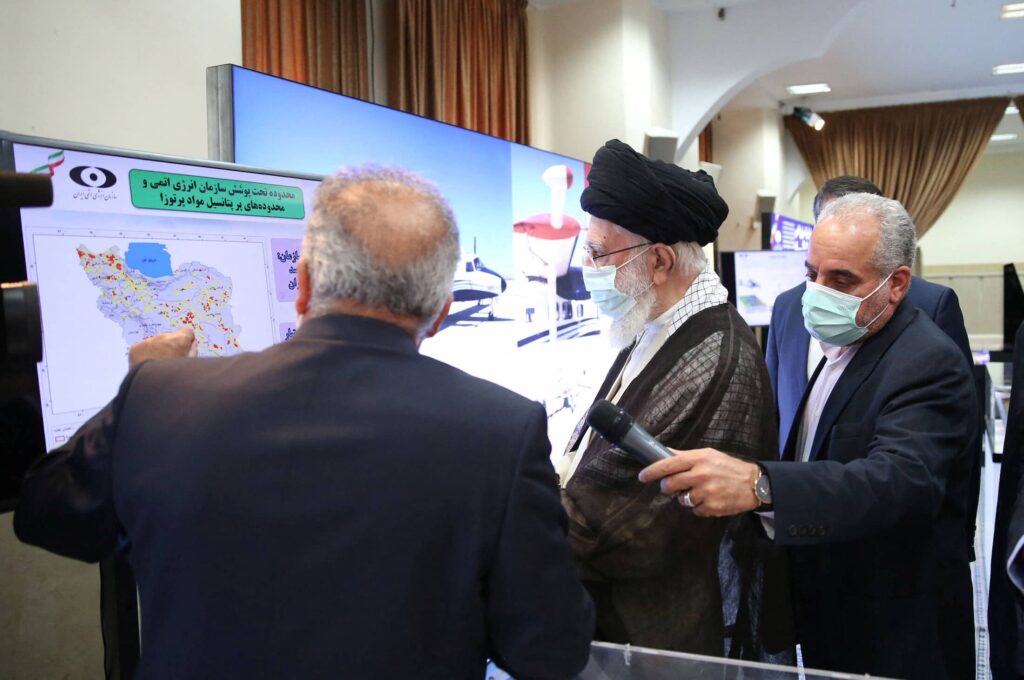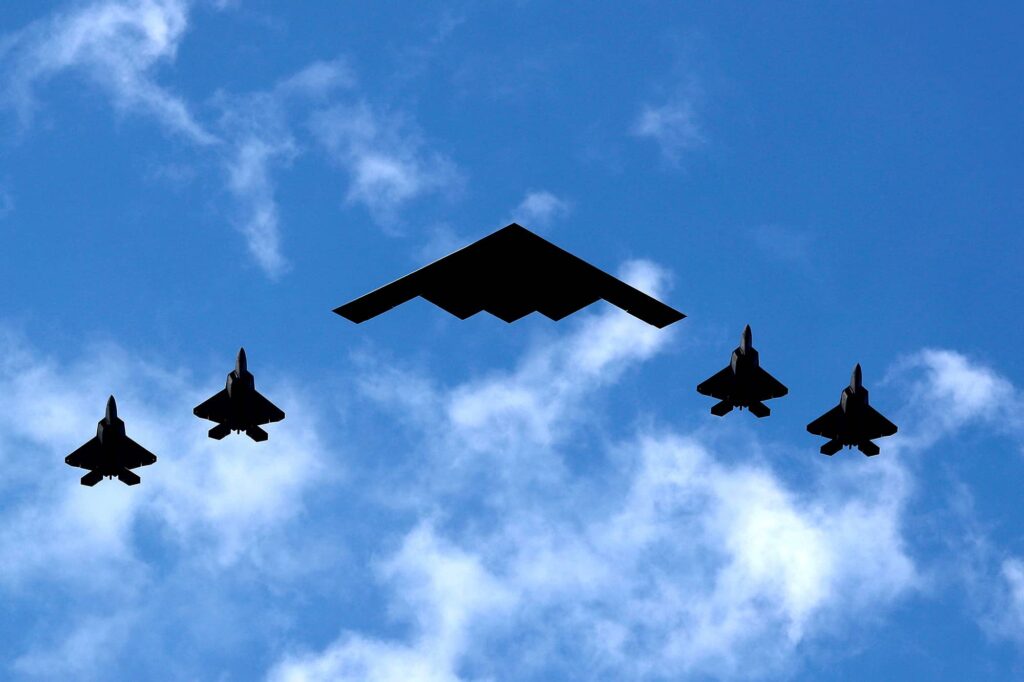The world is on fire with two major wars in Europe and the Middle East and Iran has a malign involvement in both. As a party to the Beijing-Moscow-Tehran axis it supports Russia in its aggression against Ukraine. Iran has fueled conflict through its proxies, Hamas, Hezbollah, and the Houthis, threatening America’s close ally, Israel, and upsetting regional and global stability.
In the midst of all this chaos, the most significant Iranian threat to America’s national security interests has mostly been overlooked: the nuclear challenge. According to Secretary of State Antony Blinken, Iran’s breakout timeline to a bomb is only one to two weeks.
A nuclear-armed Iran would pose a severe threat to US interests. It would increase the risk of nuclear weapons proliferation in the region as Iran’s rivals build their own nuclear deterrents in response. It would increase regional instability as a nuclear-armed Iran would be emboldened to step up its support to terror groups and proxies. It would also create the risk of nuclear attack in the region, and –as Iran increases the ranges of its missiles – against the US homeland.
Several consecutive presidents have said that a nuclear-armed Iran is “unacceptable” and all options must be on the table to prevent it.
Unfortunately, the Biden administration does not have a clear strategy to halt Iran’s nuclear progress. A Trump II administration would have an opportunity to put in place a more effective strategy.
The Failed Obama-Biden Approach
Before turning to a possible Trump II strategy, let us review several approaches that will not work. The Obama and Biden administrations attempted to solve this problem with toothless diplomacy, but their efforts failed. The starting point for today’s flawed policy toward Iran was Obama’s 2015 nuclear deal, the Joint Comprehensive Plan of Action (JCPOA).
The fundamental flaw with the deal is that it granted Iran the right to enrich uranium. There is a big difference between operating reactors for a peaceful nuclear program and making nuclear fuel. Nuclear fuel-making is dual use in nature. Once a country can make fuel for a reactor, it can make fuel for weapons. For more than half a century, therefore, US policy has attempted to draw a bright line between sensitive and nonsensitive nuclear technologies. Washington allows and even encourages countries to operate reactors, but it prohibits them from enriching uranium or reprocessing plutonium. This is a standard that applies equally to American enemies and friends. In the 1970s, South Korea and Taiwan started secret plutonium reprocessing programs, and Washington discovered them and forced the two countries to shut them down.
When it was revealed that Iran was enriching uranium in 2002, Washington’s response was immediate and unsurprising. The George W. Bush administration said that Tehran must halt its uranium enrichment program. Washington won six UN Security Council resolutions demanding that Iran cease enriching uranium. As a presidential candidate, Obama wrote in Foreign Affairs that he would stop Iran’s enrichment program.
Then it became too hard. The Obama administration badly wanted a deal, but Iran would not stop its enrichment program. So Obama moved the goalposts and undermined decades of US nonproliferation policy. He signed the Joint Comprehensive Plan of Action that granted Iran the ability to enrich uranium with limits. But—and this is a crucial point—those limits expire over time. Fifteen years after the deal went into effect, in 2030, Iran could enrich as much weapons-grade uranium as it wanted, consistent with the terms of the deal. Obama himself acknowledged that once these “sunset clauses” kicked in, the time it would take Iran to break out and build nuclear weapons “shrinks almost down to zero.”

Far from eliminating or even freezing Iran’s nuclear program, the deal had sanctified it, noted Robert O’Brien in an important Foreign Affairs article this year. It merely postponed the time of reckoning in a way that would make it harder for the United States to solve the problem in the future.
Moreover, the deal did not cover Iran’s other destabilizing activities. It did not restrict Iran’s ballistic missile production or support for terrorism. In fact, the deal lifted a longstanding UN arms embargo on Iran, making it easier for Iran to advance its deadly weapons programs.
There was bipartisan opposition to the Iran deal in the US Congress. Every Republican and some Democrats were against the deal. Several Republican candidates in the 2016 presidential race promised to tear up the deal on day one. Trump was a relative moderate who proposed to renegotiate the deal. When renegotiation proved impossible, Trump pulled out of the deal and imposed a “maximum pressure” campaign on Iran. This was the right approach, and we recommend a variation of this strategy below.
Democrats wrongly criticized Trump for pulling out of the deal, and Biden campaigned in 2020 on returning to the Iran nuclear deal. By this point, however, Biden had essentially accepted Republicans’ criticisms of the original deal. In an implicit condemnation of Obama’s agreement, the Biden administration said that they would like to get a deal with longer-lasting restrictions on uranium enrichment that also covered Iran’s sponsorship of terror and ballistic missile programs. Biden’s strategy was to quickly reenter the 2015 deal and then negotiate a “longer and stronger” deal.
Tehran had different ideas. It smelled weakness. The Supreme Leader knew that Biden, like Obama, badly wanted a deal, so he pushed for terms that would have watered down the 2015 deal. Fortunately, Biden did not go for it, and they were unable to reach agreement.
Meanwhile, Iran continued to ramp up its nuclear program. Many analysts wrongly blame Iran’s recent nuclear buildup on Trump’s withdrawal from the deal, but the evidence tells a different story. The greatest increases in Iran’s uranium enrichment program, such as enriching to high levels of purity, occurred under Biden’s watch. Tehran was afraid to test Trump, but they knew that Biden had no plan B, and there would be no consequences for a rapid nuclear expansion.
The twenty-year international effort to keep Tehran from the bomb is close to failing.
The next Republican president will need a better strategy. What should it be?
A Deterrence and Diplomacy Strategy for Iran
The United States should pursue a dual-track deterrence and diplomacy strategy to solve the Iranian challenge. So long as Iran continues with its threatening behavior, Washington should lead an international coalition to increase the economic, political, and military pressure on Tehran. At the same time, the United States should hold out the option of diplomacy, if Tehran is willing to come to the table to discuss the cessation of its destabilizing and hostile activities.
This is similar to the “maximum pressure” strategy pursued by Donald Trump in the first term. It also mirrors the dual-track strategies pursued by Bush and in Obama’s first term. This strategy would have likely succeeded had the United States remained steadfast in its prosecution. Instead, Obama’s weak deal and Biden’s desire to return to it were the aberrations that undercut a successful bipartisan US approach.
The first step of any good strategy is to clearly articulate the goal. The US goal should be for Iran to: (1) completely dismantle its uranium enrichment program and forever forswear the building of nuclear weapons, (2) halt its production of long-range missiles, (3) cease its support of terrorist and violent proxy groups, and (4) improve its human rights record. All of these are important, but goal number one is a vital US national interest. Iran must be prevented from becoming a nuclear weapons power.
Some will argue that achieving these goals will be impossible and that Washington should settle for less. But the United States should not negotiate with itself. It should make these demands and if Iran disagrees, then they can work out their differences at the negotiating table.
Moreover, as Secretary Pompeo argued, the United States did not create the above list. Iran created the list through its bad behavior. If Tehran wants to get out from under US pressure, then it simply needs to behave like a normal country. As Henry Kissinger said years ago, Tehran needs to decide if it wants to be “a nation or a cause.”

To achieve these goals, Washington should return to the pressure track. Most importantly, it should resume impose economic and financial sanctions with the goal of driving Iranian oil and gas exports to zero. These should include so-called “secondary sanctions” of any country or firm in the world that does business with Iran.
If any country or firm in Europe, Asia, or elsewhere purchases Iranian oil and gas, then it will be in the crosshairs of the US Treasury Department. This will give the rest of the world a choice. They can buy cheap Iranian oil and gas. Or they can have access to the US dollar, the US banking system, and the US market. But they cannot have both. For the vast majority of economic players, this is no choice at all. They will be forced to sever economic ties with the rogues in Tehran in order to maintain their economic relationship with the United States. By pursuing a version of this strategy, the United States was able to drive Iran into a deep recession in the early days of the Obama administration and under Trump. But later Obama, and then Biden, let up the pressure. At the time of writing, Iran is exporting more oil than before Trump withdrew from the JCPOA in 2018.
Next, the deterrence campaign should increase the political pressure on Iran. As long as Iran is unwilling to talk seriously about dismantling its uranium enrichment program, it should be isolated diplomatically. US diplomats are too busy to waste their time in empty discussions with rogue regimes. Instead, US diplomats should spotlight Iran’s role as the world’s largest state sponsor of terrorism, complicity in Hamas’ barbaric October 7 massacre, and daily human rights violations. Washington should take steps to support the Iranian people’s aspirations for freedom, including by ensuring they have access to information and the internet despite the regime’s efforts to oppress them.
Finally, and importantly, the deterrence element of the strategy will require a credible military option. The United States should make clear that if Iran dashes to the bomb, Washington will use military force to stop it. The Iranian nuclear program is a big problem, but it is located in only four nuclear facilities: Isfahan, Fordow, Natanz, and Arak. The United States has the ability to destroy these facilities using airpower, as several past defense secretaries have attested. The Iranian nuclear program could be a pile of rubble by tomorrow morning. Some of these facilities are deeply buried and hardened, but the United States has a weapon, the thirty-thousand-pound Massive Ordnance Penetrator (MOP), tailor-made to destroy such facilities. If Iran thinks that it can continue to inch its way toward the bomb, then it will do so. If, on the other hand, it thinks progress on its nuclear program will lead to a military conflict with the United States, it will stop short. Iran does not want its nuclear facilities to be bombed by the Pentagon. Tehran will be boxed in. This will provide time and space for the sanctions and political pressure to work.
A credible military option is necessary for successful diplomacy. As Reagan’s secretary of state George Shultz said: “Negotiations are a euphemism for capitulation if the shadow of power is not cast across the bargaining table.”
If, despite the resumption of a credible military option, Tehran dashes to a bomb anyway, then Washington should destroy Iran’s nuclear program. It has the ability to do so, and such strikes would set Iran’s program back for years if not forever. There are risks with such an action, such as Iranian military retaliation, but they pale in comparison to the risks of living with a nuclear-armed Iran, given thee Islamic Republic of Iran’s profound hostility toward the United States. Moreover, as Trump showed through his airstrike on Al-Quds Force commander Qasem Soleimani, Iran has few good options for military retaliation against the United States. Iran is afraid of a major war with the Pentagon and would opt for token retaliation.
The deterrence element of the strategy can succeed in two ways. The pressure may be so great that it collapses the Iranian regime, or it can set the table for diplomacy.
This brings us to the diplomacy leg of the strategy. Washington should use diplomacy even as it wages the pressure campaign to build the largest possible anti-Iran coalition. The pressure will be much more effective if European and Asian allies are supportive. Biden’s failed strategy will make building a coalition easier. US allies can see that toothless diplomacy did not work, and we need a different approach. US diplomats should pressure the Iranian regime, engage with the Iranian people, and plan for a future regime transition to a better government in Tehran.
Finally, diplomats should prepare for a return to nuclear negotiations if and when the mullahs are serious about a deal. The terms of the desired deal are simple. If Iran really wants a peaceful nuclear program, then it can have it, and the United States will help. The international community can provide Iran with nuclear reactors and fuel-cycle services. But Iran must forever forswear the sensitive nuclear activities of enriching uranium or reprocessing plutonium. It must completely shut down its sensitive nuclear facilities.
The Obama administration bragged that its nuclear deal with Iran was extremely detailed and ran dozens of pages. They cited this as an indicator of thoroughness. In reality, it was a sign of its emptiness. It was so long because the Obama administration allowed Iran to keep such a large and sensitive nuclear program. It said that Iran can maintain several nuclear facilities, thousands of centrifuges, and stockpiles of enriched uranium. It then spelled out the details of the limits on these facilities, activities, and materials. The deal then detailed the complicated verifica- tion regime needed to monitor extensive Iranian nuclear activities.
A good deal in contrast requires only one side of a sheet of paper. It will state that, like other normal countries, Iran will never enrich uranium or reprocess plutonium. The Obama-Biden deal kicked the can down the road. The strategy articulated above will forever resolve the Iranian nuclear challenge.

